The Cathedral of the Holy Cross and Saint Eulalia (long name, I know) feels like it often plays second fiddle to Barcelona’s most famous church, Gaudi’s masterpiece La Sagrada Familia. But the Barcelona Cathedral is truly a treasure unto itself and worth exploring in its entirety. While La Sagrada is a modernist miracle, the Barcelona Cathedral is a gothic gem. Although there are many similarities between the two once you really investigate them both. Gaudi himself was inspired by this historic church upon designing La Sagrada. Gaudi would have come here as a youngster and looked up at the soaring gargoyles, angels and pinnacles in childlike awe. That same awe-inspiring feeling is still there today! So head inside and see everything there is to explore!

Hours and Access
The church is located in the Pla de la Seu, right in the centre of the Gothic Quarter. To get there you can take the Metro to ‘Jaume I Station‘ on line 4. It is also easily accessible on foot if you’re already in this area of town.
The Cathedral’s opening hours for visitors are as follows:
Monday to Friday: 8 am-12:30 pm and 5:45 pm-7:30 pm.
Saturdays: 8:30 am-12:30 pm. and from 5:15 pm – 8 pm.
Sundays and Holidays: 2:00 pm – 5:30 pm
During the rest of the time, the Cathedral is dedicated to religious worship only. Although you are more than welcome to attend, no photography is permitted during this time. You are expected to simply spend this time in respectful prayer. While there are no days when the building is officially closed if you’re visiting during a holiday its best to check their website schedule for updated visiting hours.

Admission
While entry into the Cathedral is free there are certain areas that require admission. The main nave of the cathedral and the cloisters are both accessible without a ticket. Entry into the Choir costs €3, the Terraces and lift cost €3. Alternatively, you can get these two tickets PLUS entries into the chapel and Sala Capitular museum for €7. The later is the best deal. The view from the rooftop terraces is amazing so I’d recommend it. Be warned the terrace closes 30 minutes before the rest of the church. Don’t forget about this especially if you’ve already purchased your ticket. Unless you’re visiting during the absolute peak of tourist season, you can easily buy your tickets upon arrival inside.
Tips
I visited the Cathedral twice on my first visit to Barcelona. Despite not having an issue buying a ticket, I did find that when I visited in the afternoon the cathedral was quite busy. Since it was so crowded so I returned the next day in the early morning just as it opened. This time of day is really magical. The sun rises just behind the Cathedral and the usually packed square in front of the church is full of nothing except the sound of your footsteps.
Be sure you have adequate clothing for entry which requires a modest attire; arms and legs must be covered up and no hats. I always bring a little scarf I use to cover my arms if I’m wearing a strappy top. I also carry a pair of leggings in my backpack. This is a great trick for days when it’s too hot to wear pants but you need your legs to be covered.

History
The church is dedicated to Saint Eulalia, the patron saint of Barcelona. Eulalia was a beautiful young woman who once lived in Barcelona. One day, she was attacked by a group of Roman soldiers in the square. She was persecuted for her religious beliefs and stripped naked in front of a horde of people. She was ashamed but in the middle of the summer, it began to snow, covering her naked form.
Unfortunately, this only enraged the Roman soldiers and they threw her in a barrel. They proceeded to stab the barrel with knives and rolled her down the street until she was dead. Today, that same street is also named after her as well. Her sad but powerful story is one which stuck with the people of Barcelona. This church was built in her name, “Baixada de Santa Eulàlia“. Her body was saved by her fellow Christians and is now entombed inside the Cathedral. Very poetic.
First Romanesque Church
The very first romanesque church was built here in 1058. Over the years it fell into ruins. During the Gothic period, the old church was destroyed and w new one built on its foundations. Construction began for the Cathedral of Barcelona in 1298 but wasn’t completed until 1420! That’s over 100 years! The cloisters were the last part of the church to be finished, completed in 1448. In the 19th century, a neo-gothic facade was added. It was designed with the same beautiful gothic elements of the rest of the cathedral so it seamlessly blends in. It’s so rare to find a cathedral this old which hasn’t had multiple renovations and restorations. The fact that most of the church contains art and architecture from the 15th century is such a treat to behold.

The Facade
Looking at this ornate facade, simply dripping in decorations, it’s hard to imagine that it once was nothing more than a plain exterior. Most Catalan churches built at the time featured a flat, nondescription facade. This neo-gothic marvel was built years after the initial construction of the church in the 19th century. It was designed by architect José Oriol Mestres. Mestres wasn’t an immensely popular architect, with only a few other buildings in his repertoire. Perhaps the Cathedral was his greatest accomplishment and once it was completed nothing could compare.
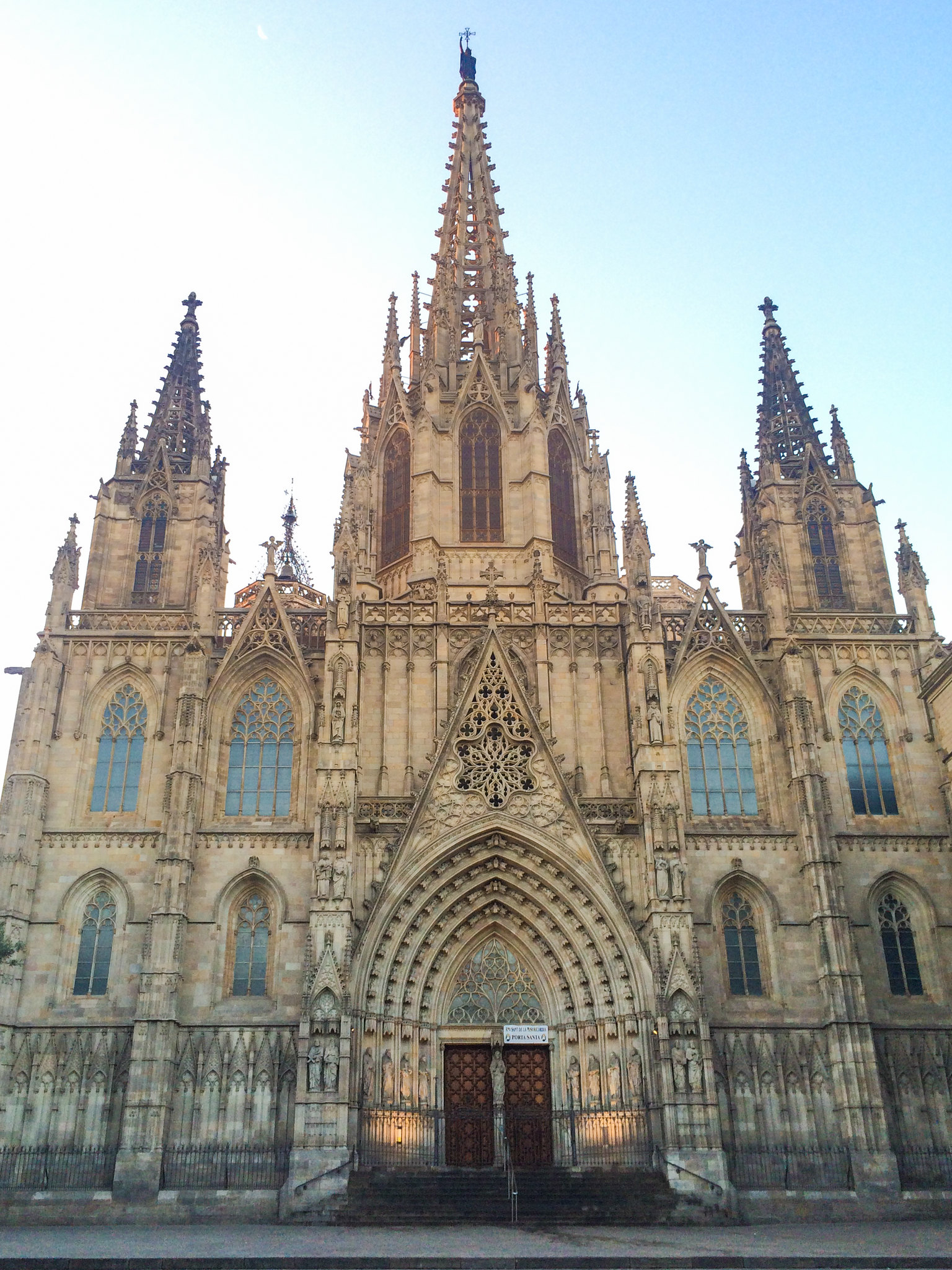
The stained glass windows you can see inside the towers were taken from the Renaissance exterior. The stained glass located on the lower portion of the facade are more modern interpretations. The tracery windows are some of the most ornate examples of neo-gothic design and seem to weave together like ivy or branches or a tree. The rose window, which is typical of other neo-gothic buildings, is here portrayed in a different fashion than most. Instead of a circular rose, with inside petals, the rose window here is designed without the outer portion. The petals of the rose each feature a quarterfoil symbol which spills out above the top of the rose window. This is more of the unique aspects of the neo-gothic design.
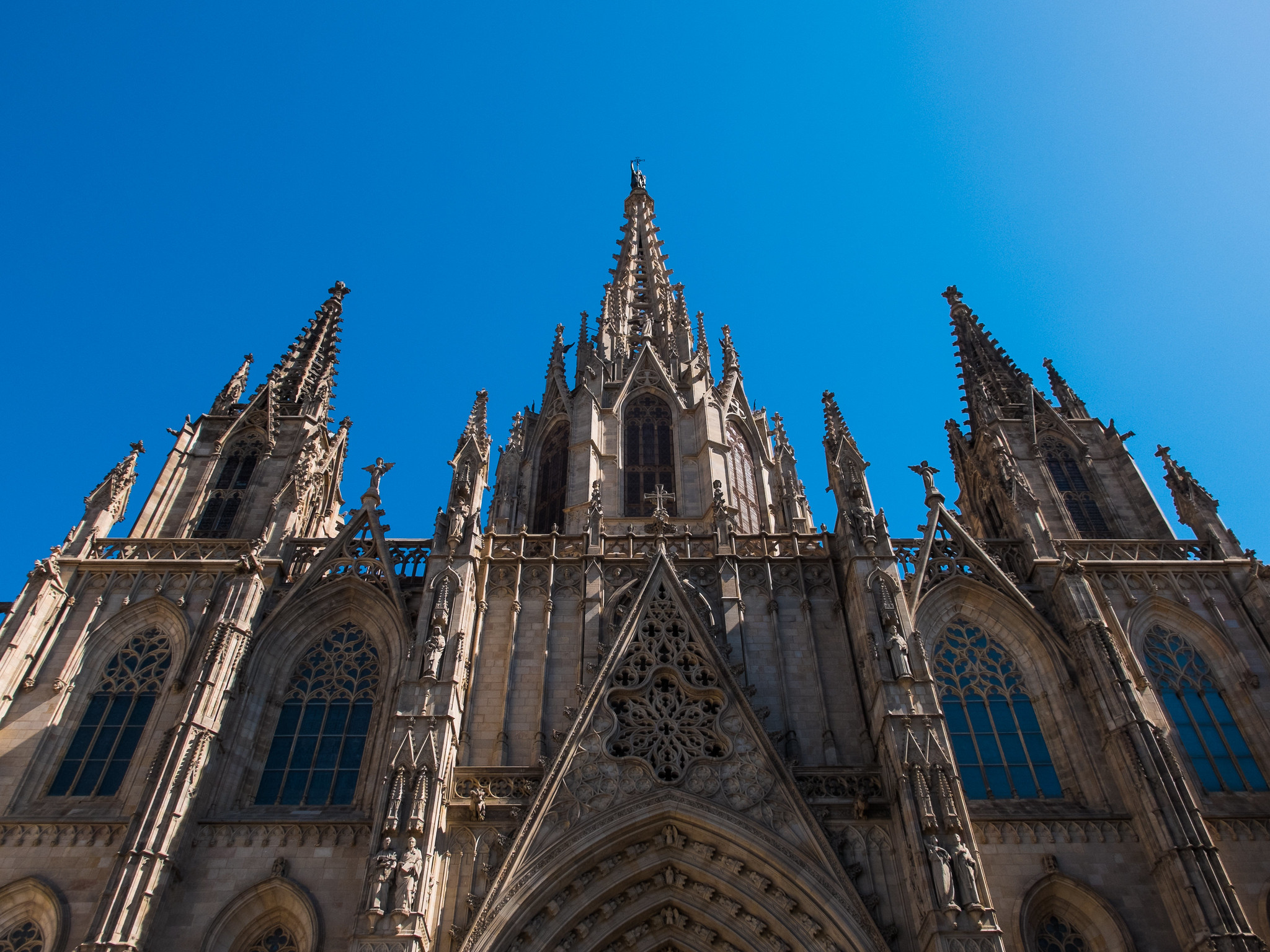
Entry Doors
One of my favourite parts of the church is the neo-gothic archivolt above the church’s entry doors. An archivolt is an ornamental band that follows the curve of the underside of an arch. Upon this archivolt are carved, 100 angels flying above your head! In the centre of the two, large wooden entrance doors is a stone sculpture of Jesus, flanked on either side by statues of the 12 apostles. 75 figures in total adorned the exterior of the facade, featuring more saints, kings and famous prophets. While the sculptures of the people are stern and noble, there are also various playful gargoyles and mythical animals which also decorated the stone walls.

Towers
The cathedral is home to three towers, two side towers and a large central cimborio. A cimborio is a classical element of Catalan architecture which is a raised dome or a cupola that acts as a lantern over the crossing of a Gothic cathedral. This cimborio is what allows natural light flood the otherwise darkened interior. A bright interior is one of the most important parts of a Gothic cathedral so the cimborio is a clutch element. The cimborio is crowned by the copper statue of Saint Helena. The family from Girona, who financed most of the cathedral’s construction in the 19th century, were devotees of Saint Helena. The family wanted to be able to see their patron saint at all times, high above the rest of the buildings in Barcelona.

The two side tower, located over the Doors of Saint Ivoand and the Cloisters, were added in the 19th century. Each tower is adorned with two lateral pinnacles. Every inch of these towers is embellished! Leaves curls around the edges, gargoyles pop out from every corner and angel play musical instruments, a choir over the top of the city.
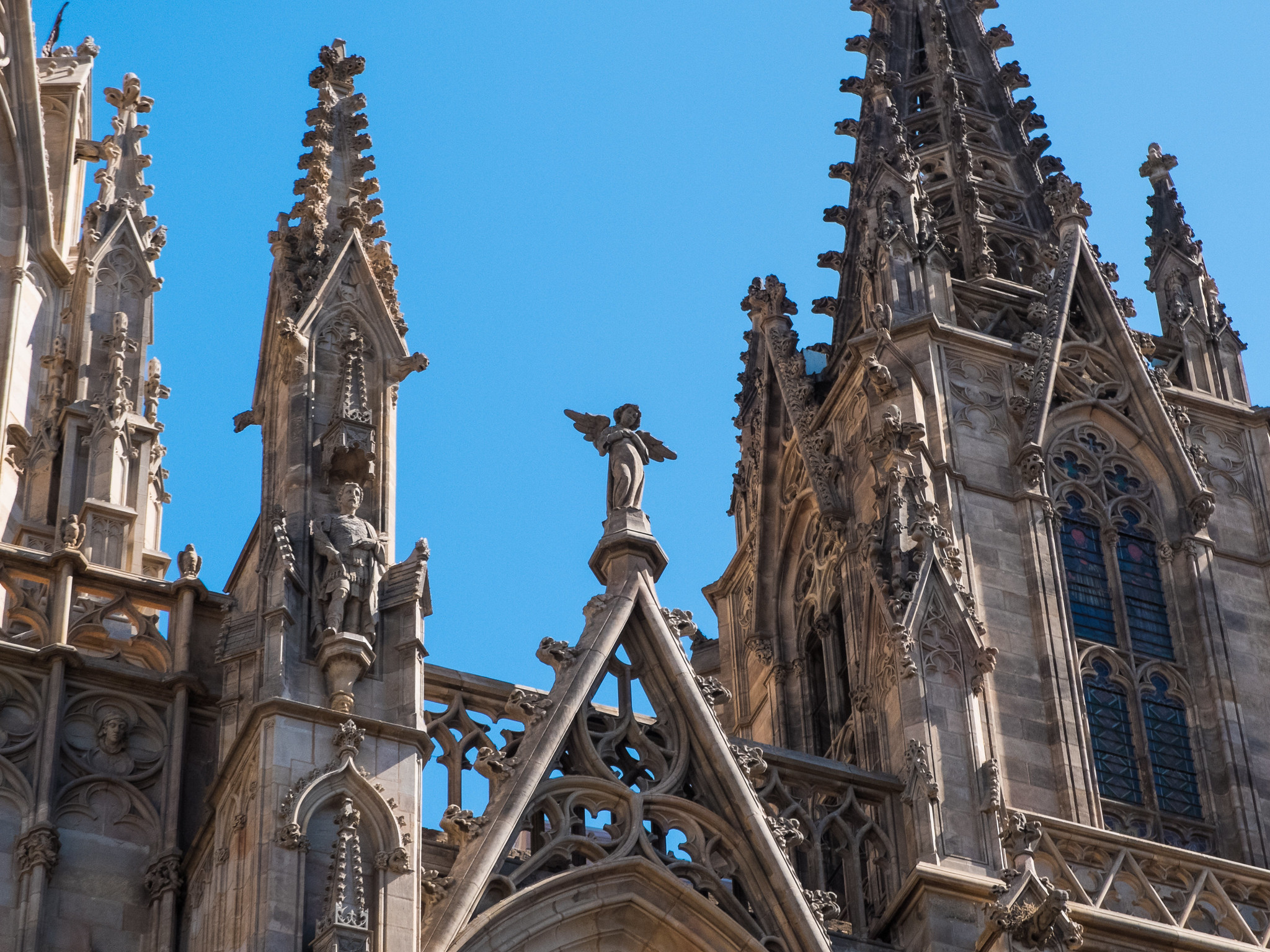
Doors of Saint Ivo
Before heading right into the church, walk over to the Plaça Sant Iu, on the northern side of the Cathedral. Here, on the steps of the entrance to the Museu Frederic Marès, you can study the ancient Doors of Saint Ivo. This was the primary entrance in the cathedral for over 500 years, located right under the northern bell tower. The doors are named “Saint Ivo” because, in the 15th century, Saint Ivo was the patron saint of Lawyers. Lawyers were one of the main contributors to the cathedral’s construction and as such they demanded their patron saint be honoured.
The doors were built from marble which had been brought all the way from the precious Montjuïc mountains, close to Barcelona. They were built in 1298 and have stood here untouched ever since. On either side of the columns which flank the doors are carvings of knights fighting mythical beasts. These capitals were rescued from the ruins of the ancient Romanesque cathedral. Once they were uncovered the architecture knew they needed to be incorporated in the cathedral somehow. Below these capitals is a large inscription, surrounded in floral carvings. This inscription bears the date of May 1st, 1298, the day work began on the construction of the gothic cathedral.
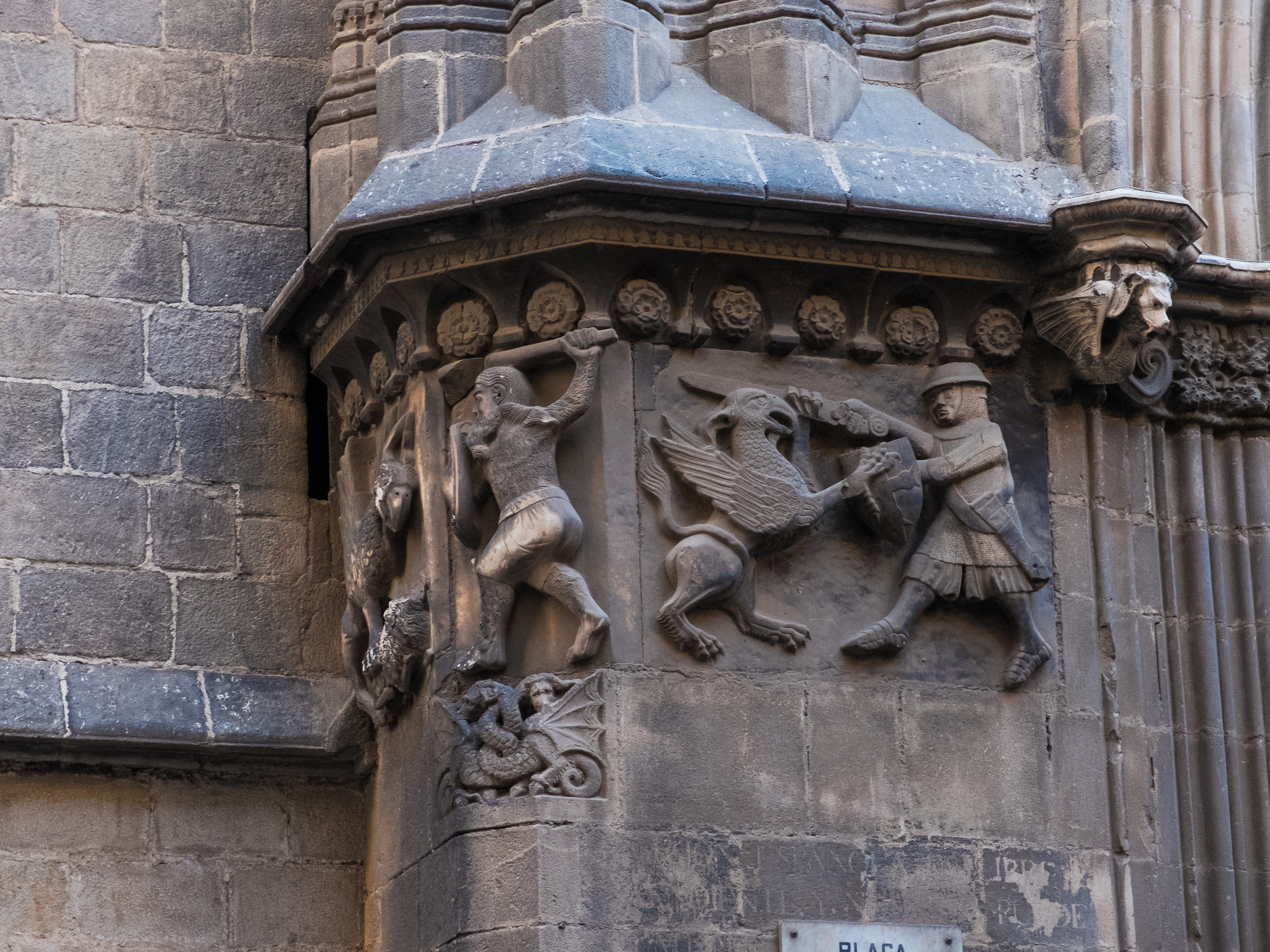
Interior
The interior of the cathedral features the gothic design of a unified apse system. The two side aisle and central nave are all connected together but the aisles are distinguished from the nave by having a distinctly lower ceiling. The side naves and ambulator feature monuments and chapels dedicated to over 140 different saints! While we won’t go into all of them here I did try my best to highlight the most important ones.
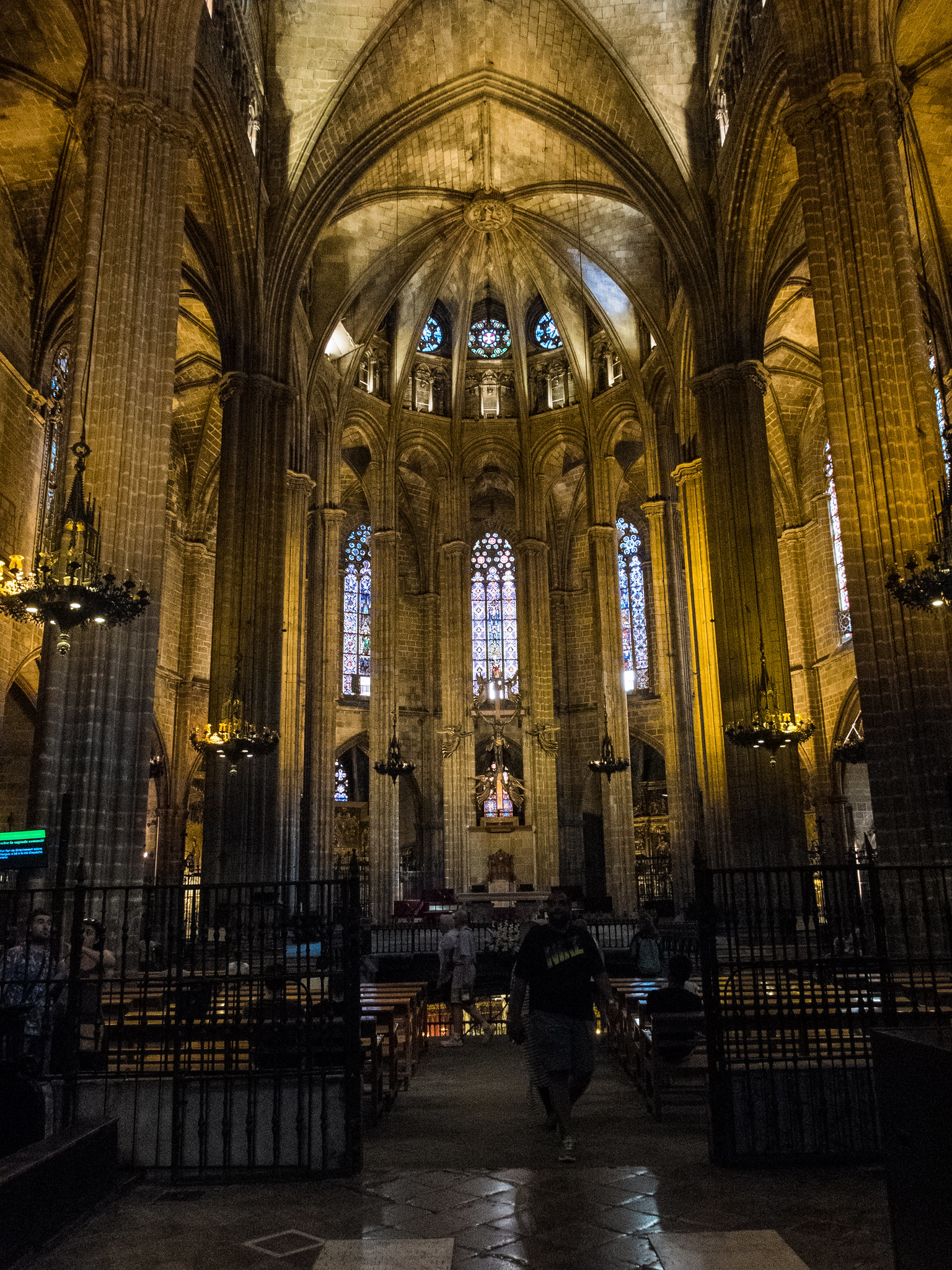
Entry into the Nave
Upon entering the nave through main front doors, you’ll step directly into the grand nave of the church. You’ll be struck immediately by the warm yellow light which sets the interior all aglow. Most of the blackened parts of the decor are not from age but from hundreds of years of candle soot. Take a seat in one of the pews in front of the choir and look up at the ceiling. Along the vaults of the cathedral are 215 beautifully carved keystones which date back the 14th and 15th century. These once were covered in colours polychrome but after years of deterioration, they are now just plain carved stones.

Right above this area of the nave, we can see the keystone of Saint Martha. Other famous keystones to look out for are Jesus being crucified between the Virgin and Saint John, with the symbols of the sun and the moon. See if you can spot Saint Eulalia with the coat of arms of Blanca of Naples, covered in Fleur-de-lis. Our Lady of Mercy is seen using her cape to shelter a pope. There is a king, a cardinal, a bishop and a canon on one side, and a queen, a nun and three other feminine figure on the other side along with the Annunciation of the Virgin with the Archangel Saint Gabriel. And finally, the eternal father surrounded by angels.
Stained-glass windows
The Cathedral has many Gothic and modern stained-glass windows. The central panels depict the image of the central characters to which the piece is dedicated. The side panels feature richly coloured geometric designs, coats of arms of royal families, trefoil and quatrefoils, and sometimes even architectural features that bring a meta element to the design.

Bishop Ponç de Gualba & Holy Cross and Saint Eulalia,
The stained glass windows throughout the cathedral are from various periods in the building’s history. The earliest ones date from the 14th century and bear the coat of arms of Bishop Ponç de Gualba. These windows depict the Holy Cross and Saint Eulalia, Saint Sylvester, Saint Peter and Saint Stephen. Later in the 1400s we see stained glass windows dedicated to Saint Andrew with the coats of arms of Bishop Armengol. The most impressive of the windows, located in the bapistery chapel, was made by artisan Gil de Fontanet in 1495 and depict the Saint Michael archangel and Noli me tangere. The most recent stained glass windows, found on the facade are all from the 19th and 20the century.
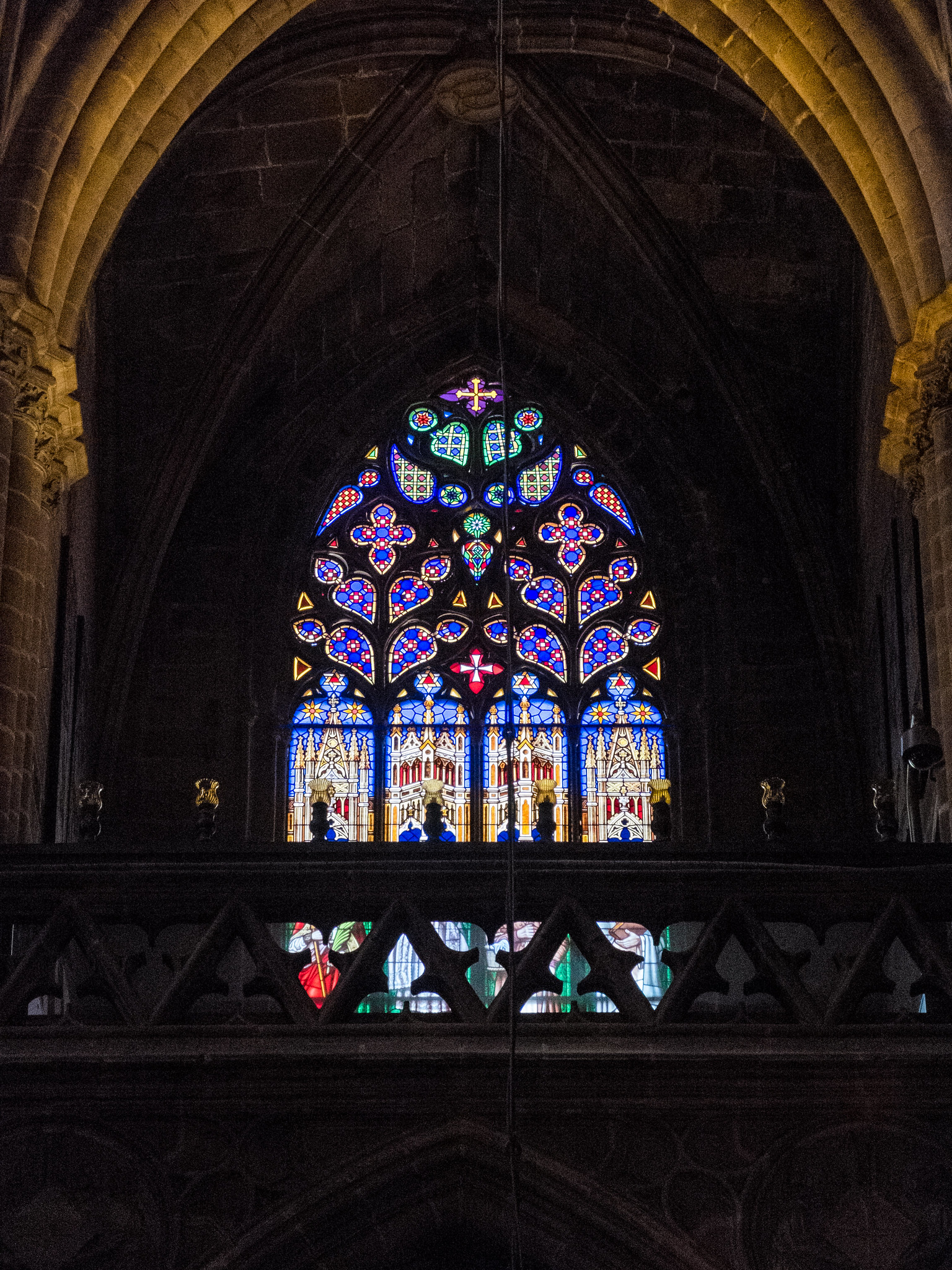
It’s amazing to see that even some of the windows which are hundreds of years old, still explode with colour! This cathedral wasn’t about steering away from loud, and expressive designs. Instead it wanted to make its visitors feel powerful emotions upon stepping into this haven of light.
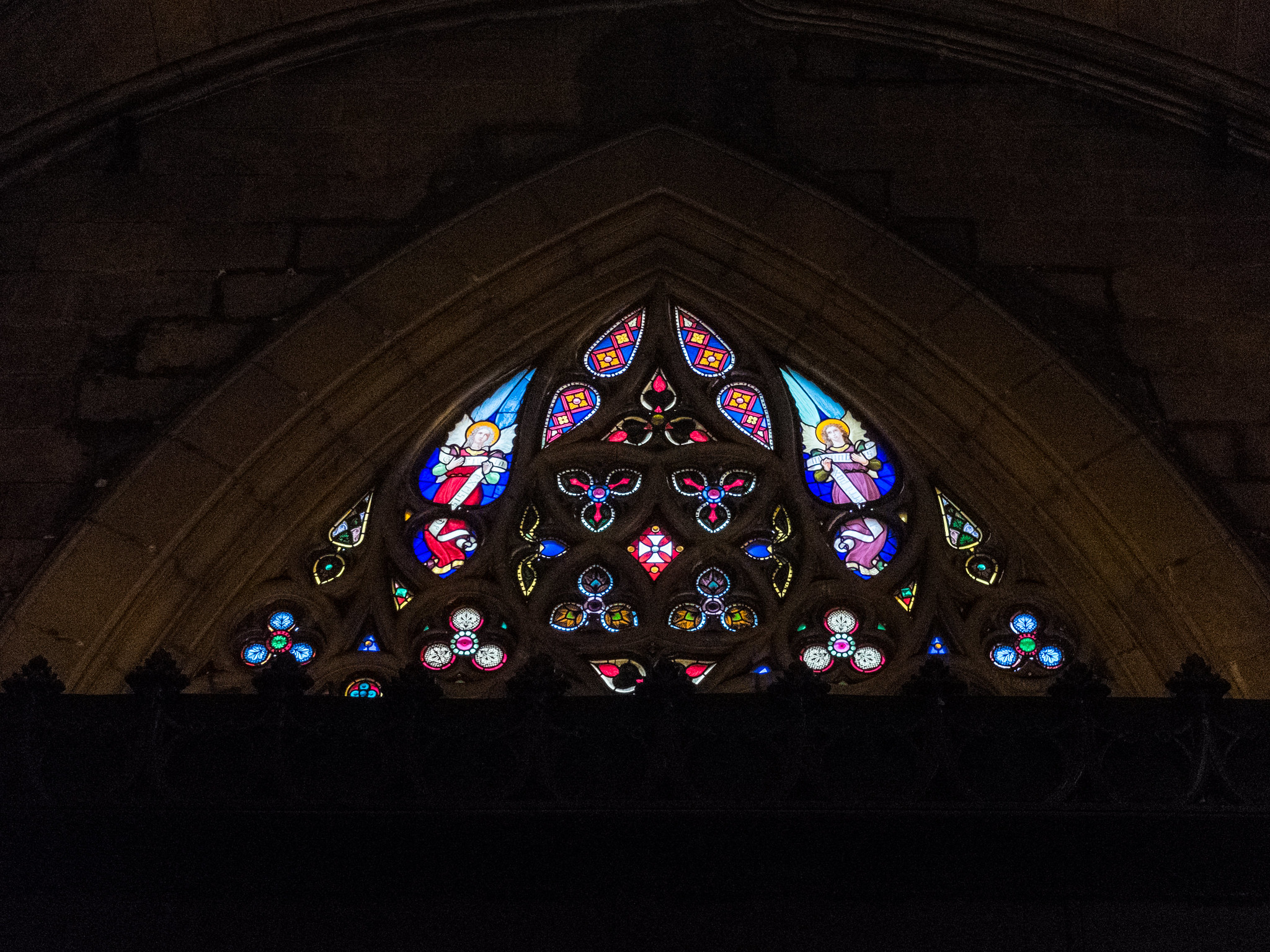
Chapel of the Holy Sacrament and of the Holy Christ of Lepanto
Just to the right as you enter, you’ll find a darkened chapel. At the back of the room is a golden arch, which seems radiate with light as it is the only real light source in the room. This is the chapel of the Holy Sacrament and of the Holy Christ of Lepanto. In the centre of the chapel is a beautiful, black wooden sculpture of Jesus Christ on the cross. Look closely and you might notice that Jesus almost looks like he is leaning to one side. This is because of a very famous legend from Barcelona which took place during the battle of Lepanto, in October 1571.
The Christian states of Europe all worked together in this battle to defend their land against the invading Ottoman empire. At the time, it was not only the largest naval battle in history but also the bloodiest. In just a few hours over 50,000 soldiers lost their lives. The legend goes that the crucifix we see here today was mounted upon one of the ships. As a means of protection for the soldiers. During the battle, a large cannonball shot towards the boat which carried the crucified. The soldiers claim they saw the statue, which was right in the line of fire, dodge the oncoming canon ball. This is why we still see him in this position today, in mid dodge. It’s said that the defending Habsburgs army saw this as a good omen and it was part of what propelled them to victory.
Saint Olegarius
Also located in this chapel, although only partially visible, is the tomb of Saint Olegarius. Saint Olegarius, served as bishop of Barcelona in 1116. Saint Olegarius’s body is actually one of the few saints body’s to be incorrupt. Incorruptibility is a belief that by some divine intervention a human body avoids the normal process of decomposition after death as a sign of the body’s holiness. Inside Saint Olegarius’ tomb, his corpse is still dressed in the regal bishop’s robes he wore in life. Every year, on March 6th, the tomb is opened up and visitors can gaze down into the glass casket and see the unchanged body for themselves.
Saint Chapels
There are over 28 chapels flanking the cathedral’s nave. You can find a list of all the saint chapels here if you’re looking to prayer at one in particular. Each one of the chapels is dripped in golden leaf decorations, magnificent paintings which tell stories of the saint’s life, and powerful sculptures which look out at you from the gates which separate from the holy from the mortal realm.


Chapel of Baptism & Font
Against the wall where the entry doors are located is the Chapel of Baptism. Here you’ll discover the huge marble baptismal font which has been used inside this cathedral since 1433. Behind the font is a small relief carved into the marble altarpiece of Jesus Baptising one of his disciples.
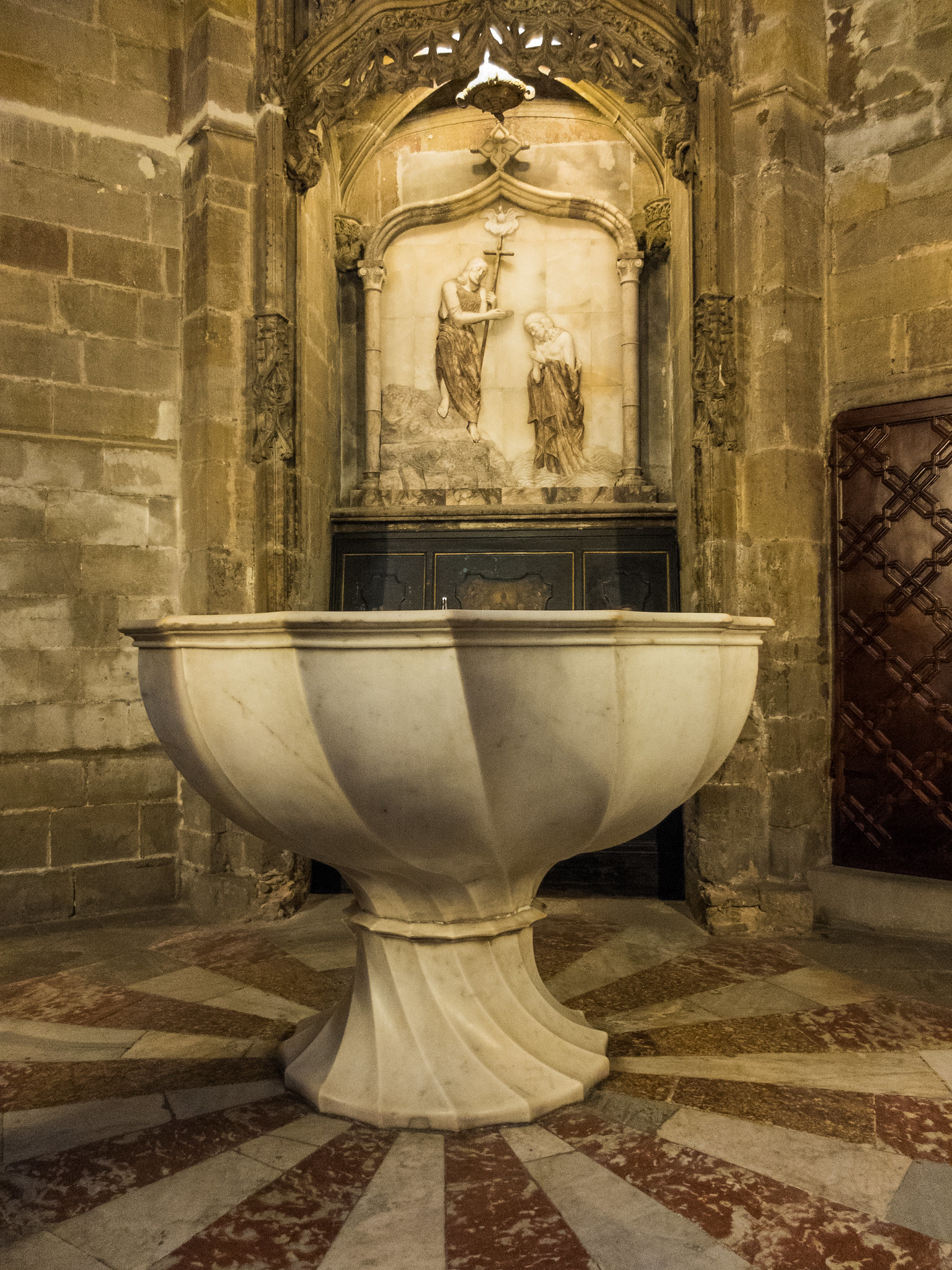
Saint Severus Chapel
To the left of the pews in the back of the nave, you’ll find the chapel of Saint Severus. If you’re a Harry Potter fan like me, your ears will perk up upon hearing this name, as I had never heard it before those books, but it turns out, it’s a fairly old name. Saint Severus was once the bishop of Barcelona but was murdered for his beliefs in 304. Romans soldiers captured him and tortured him into renouncing his Christianity. When he refused for the final time, he was sentenced to death.
The soldiers hammered nails into his head and yet he would not die. When fellow Christians heard of his persecution they came to his aid but unfortunately, were too late. As they took him down, he died in their arms. In1405, his relics, which were previously housed in Sant Cugat, were moved to Barcelona. It was rumoured that these relics helped cure King Martin I of gangrene in his leg! You can see a depiction this event in the top right corner.

Choirstalls
In front of the first set of pews in the nave is the choirstalls. Guarding the entrance to the stall is a great stone wall with stunning carved reliefs. The depictions on the relief tell the story of Saint Eulalia and her eventual death. In between these extremely gruesome and powerful carvings are niches with statues of Catalan saints.

Order of the Golden Fleece
The interior of the choir stall is dedicated to the knights of the Order of the Golden Fleece. The order was founded to defend the Roman Catholic religion and to uphold the usages of chivalry. The order settled disputes, crimes and the actions of the knights of the order. If a knight was thought to have committed an offence or rebelled, they were brought to trial among their peers and not to the public justice.

The choirstall’s design is thought to be the finest example of Gothic Catalan architecture. To study the ornate canopies and pinnacles, walk around the exterior of the choir before heading inside. The walls surrounding the choir are decorated in Doric columns and crowned with an ornate balustrade.
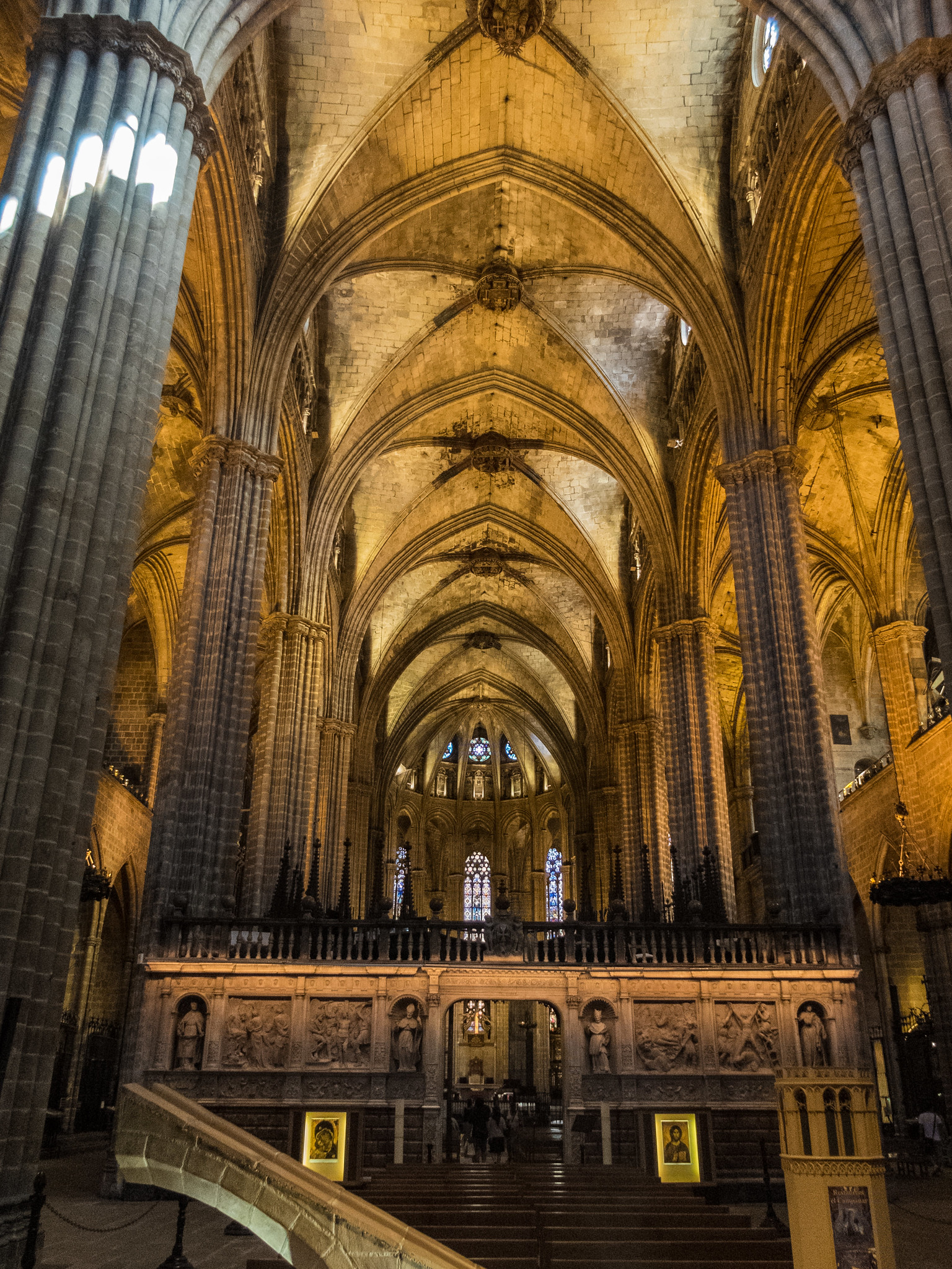
Knights of the Order of the Golden Fleece
During the first few years of the Order of the Golden Fleece there were only 20 knights but as the years went on it expanded to over 60 members. Today you can find the coats-of-arms of the knights painted onto the various seat backs inside the choirstall. Most of these were painted in the 16th century although the older looking ones were made as far back as the 14th and 15th centuries. Even each of the chairs themselves has these gorgeous little carvings of animals and minature statues on the seats. No aspect of the choirstalls was left unembellished. Inside the choir, you’ll find a wonderfully carved wooden pulpit made by Pedro Çanglada in 1403.

Chapel of Raymond of Pennafort
On the South wall, opposite the choir stalls, you’ll find the Chapel of Raymond of Pennafort. Raymond, a strange name for a saint, is the patron saint of Catalan lawyers. One of the best parts of visiting this cathedral is learning all about the Catalan saints you won’t hear about anywhere else in the world! Raymond studied law at the University of Bologna and was one of the chief advisors to the Pope and King James I of Catalonia and Aragon. One of his miracles was said to be sailing from Sóller to Barcelona on nothing but a simple blanket!
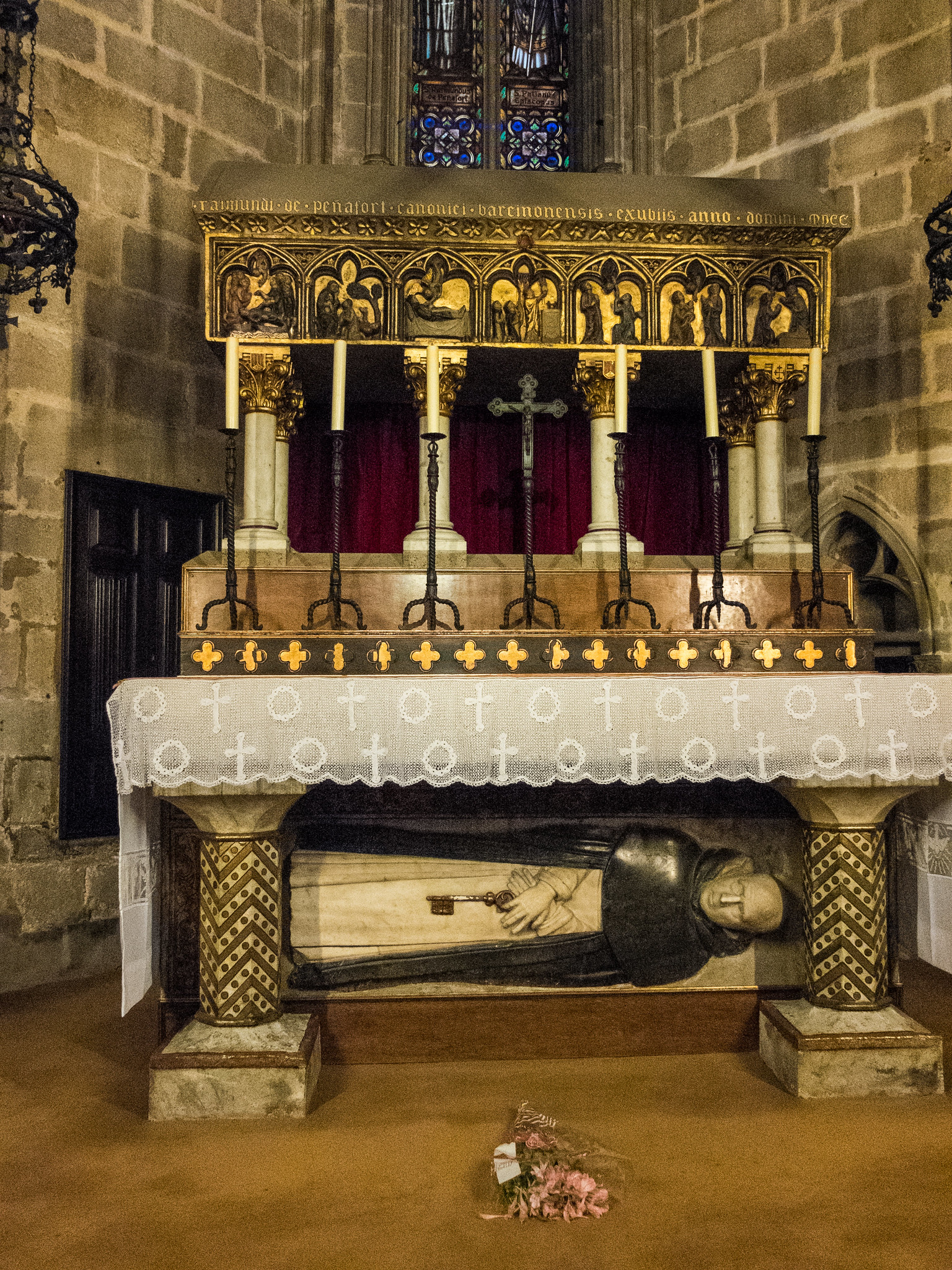
Saint Pacian Chapel
Continuing along the south wall, you’ll come to the Chapel of Saint Pacian. Saint Pacian was bishop of Barcelona during the second half of the 4th century. He is highly regarded as one of the founding father’s of the church in Barcelona. The altarpiece inside the chapel is a baroque masterpiece made by sculptor Joan Roig from 1688. It depicts various scenes from the life of Saint Pacian and Saint Ignatius of Loyola.
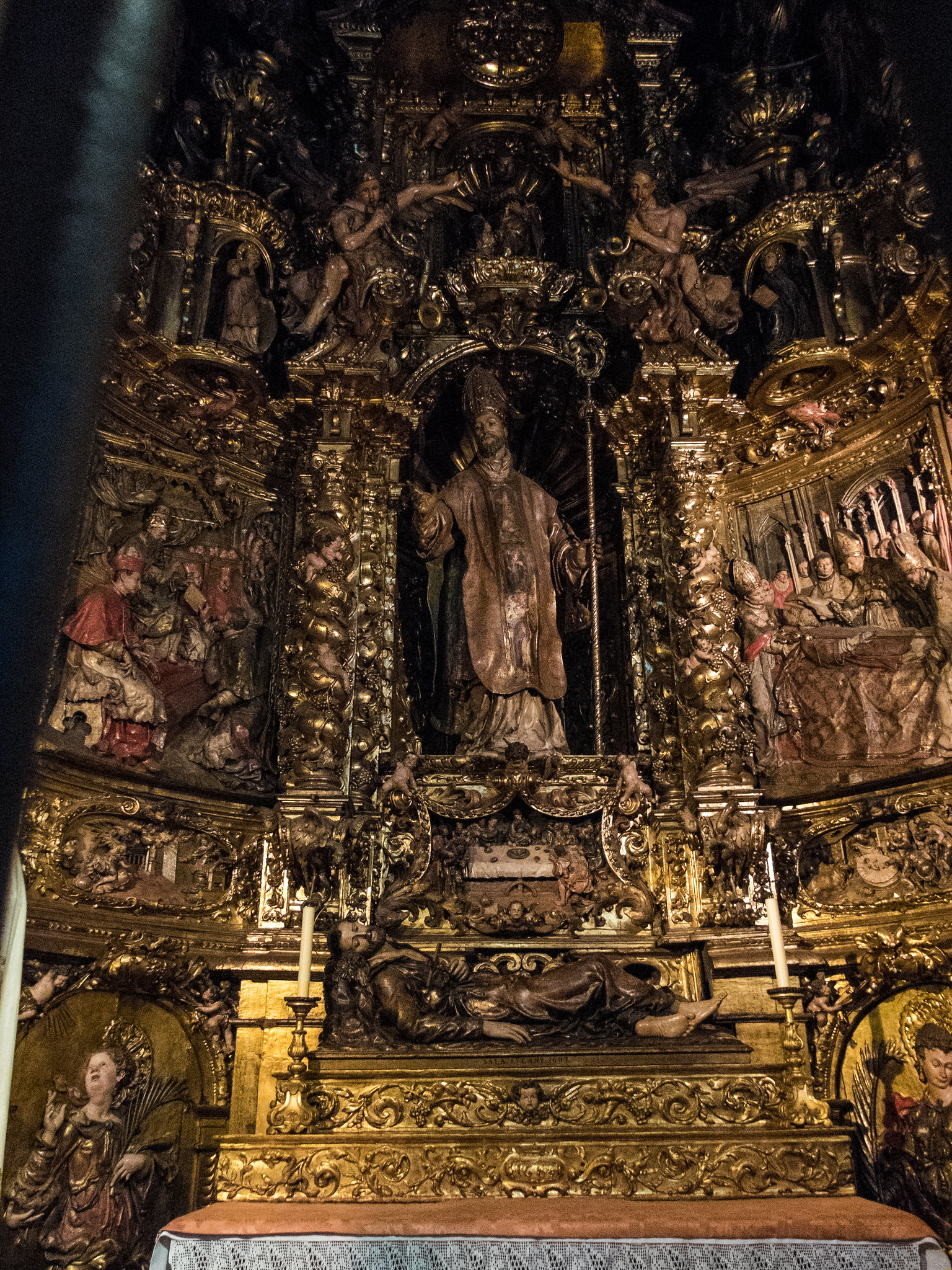
The Organ
The fantastically carved organ, which hangs above the doors of Saint Ivo is truly the definition of “heavenly”. Built in 1539, the organ is designed in high baroque style. Cherubs top the pipes and Saints faces reveal themselves from the flat wooden facade.

Crypt of Saint Eulalia
Below the high alter, a set of stairs descends into the ground where you’re met with a pair of iron gates. Behind these gates, you can see a large stone tomb topped with a beautiful statue of a young woman. This is the crypt of Saint Eulalia. Her sarcophagus is adorned in gothic, polychromed alabaster and inside rest her remains. The carvings around the tomb depict the story of her martyrdom after leaving her home of Sarria at the age of 13. The scenes of her martyrdom are quite affecting and powerful, and not for the faint of heart. They show her being whipped by soldiers, and how they used a hook to tear the flesh off her body when she was nailed to the cross. Pretty gruesome, lucky you can’t see it up close really.

The carvings also show how her remains were moved to the cathedral from the Basilica of Santa María. Above the tomb, in the centre of the room, we have a statue of the Virgin Mary. On either side of her are four angels holding candles sticks. This tomb is a new incarnation from the 13th century but right behind it you can still see a piece of brokem marble from the original one. This tomb was made in 878!

High Altar
Above the tomb of Eulalia, we have the High Altar. The Altar is made of pure white marble and measures over three feet long. Above the altar hangs a grand crucifix, held up by six triumphant angels.
Ambulatory
At the east end of the cathedral, we find the ambulatory with its nine radiating chapels. These chapels are located behind high altar, raised above the crypt of Saint Eulalia below. The nine chapels located in the ambulatory are crowned with tall, glowing stained glass windows. This allows for the most heavenly, colourful light to pour over the high altar.

Rooftop
To access the roof, head towards the tower on the northern side of the cathedral. From here you take a lift to the top (you need a paid ticket) where you have a 360-degree view of the city.
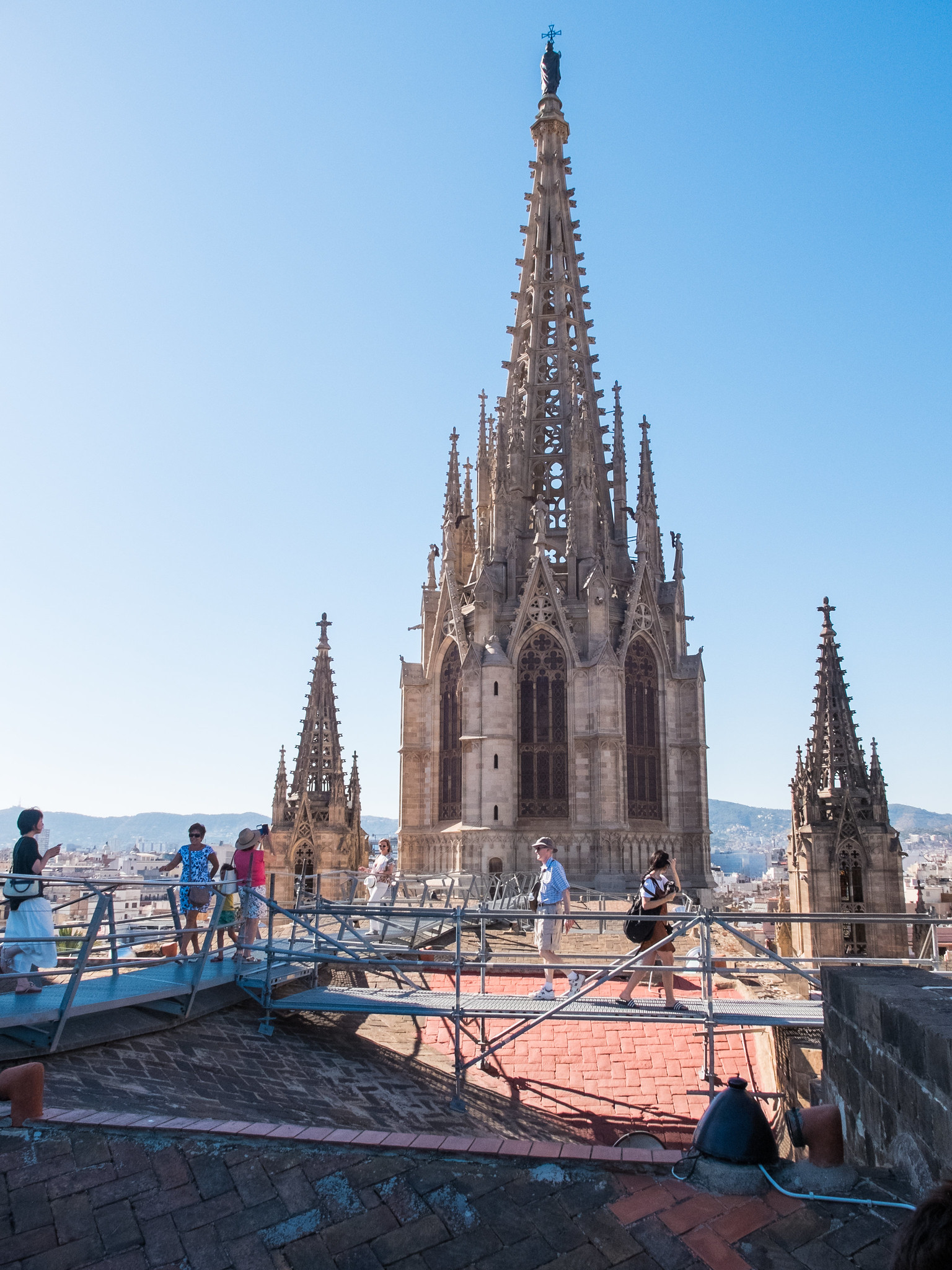
The rooftop gets you up close to the various gargoyles and mythical stone creatures who call the roof their home. If you’re here anytime during the lunch hour you might have the chance to hear the bells ring. While you can hear these bells all over the city there is something so overwhelmingly awesome about hearing them so close.
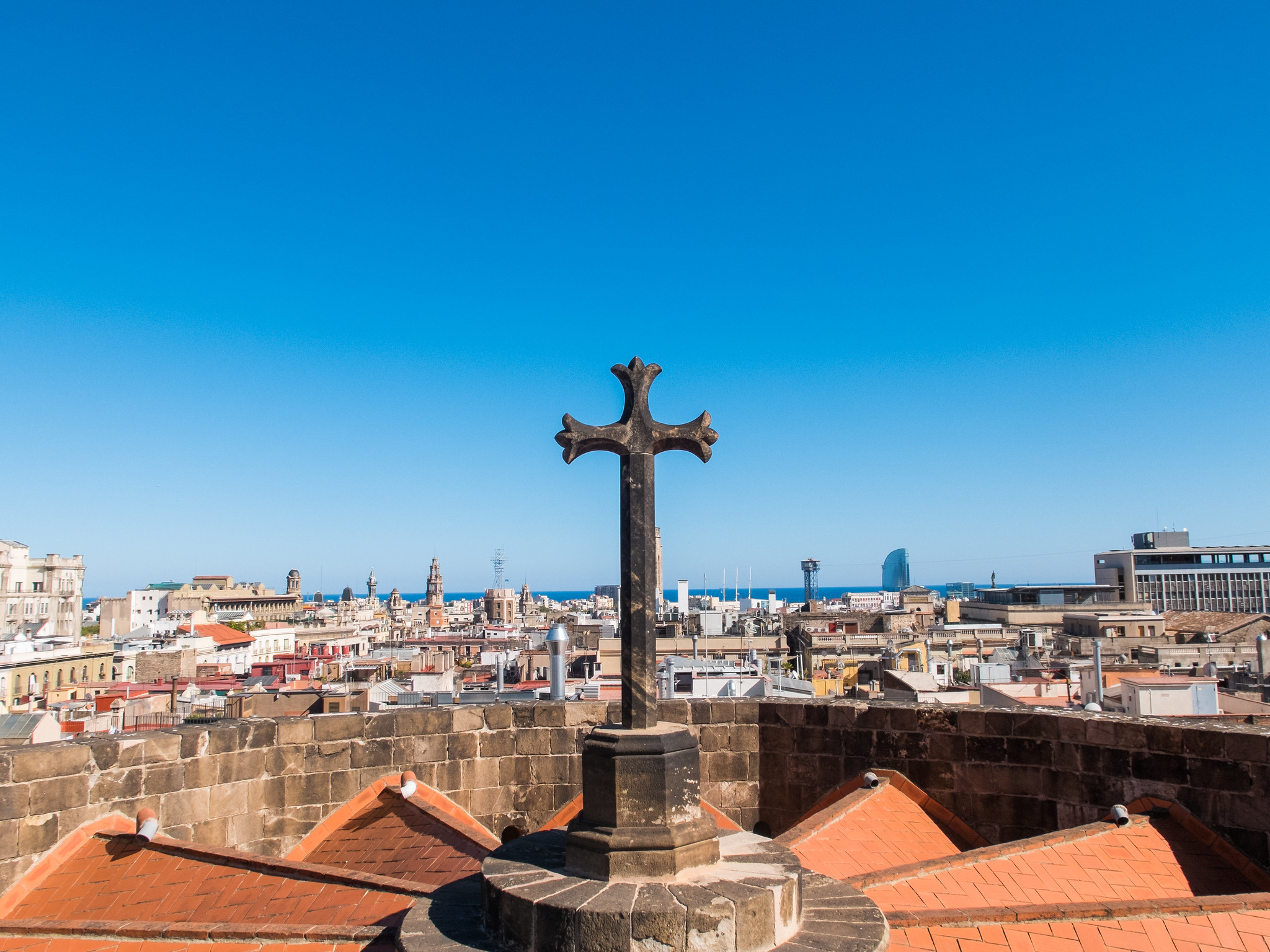
Cloisters
To access the cloisters, you pass under a large white marble door. This is said to be a recovered piece from the original Romanesque cathedral built on the site in 1046. The archivolts here are decorated with geometric patterns but framed in gothic pediments.

The reliefs sculpted into the pillars of the Cloister’s arches show scenes from the Old Testament and from a legend about the Holy Cross. The keystones set into the vault depict scenes from the New Testament.

Each out of outdoor chapels here was initially dedicated to the patron saint of an institution or guild. They were built here under the protection of a specific family. Look on the floors and you can see markings of these guilds. the one below depicts a pair of scissors to represents the cloth merchants guild.
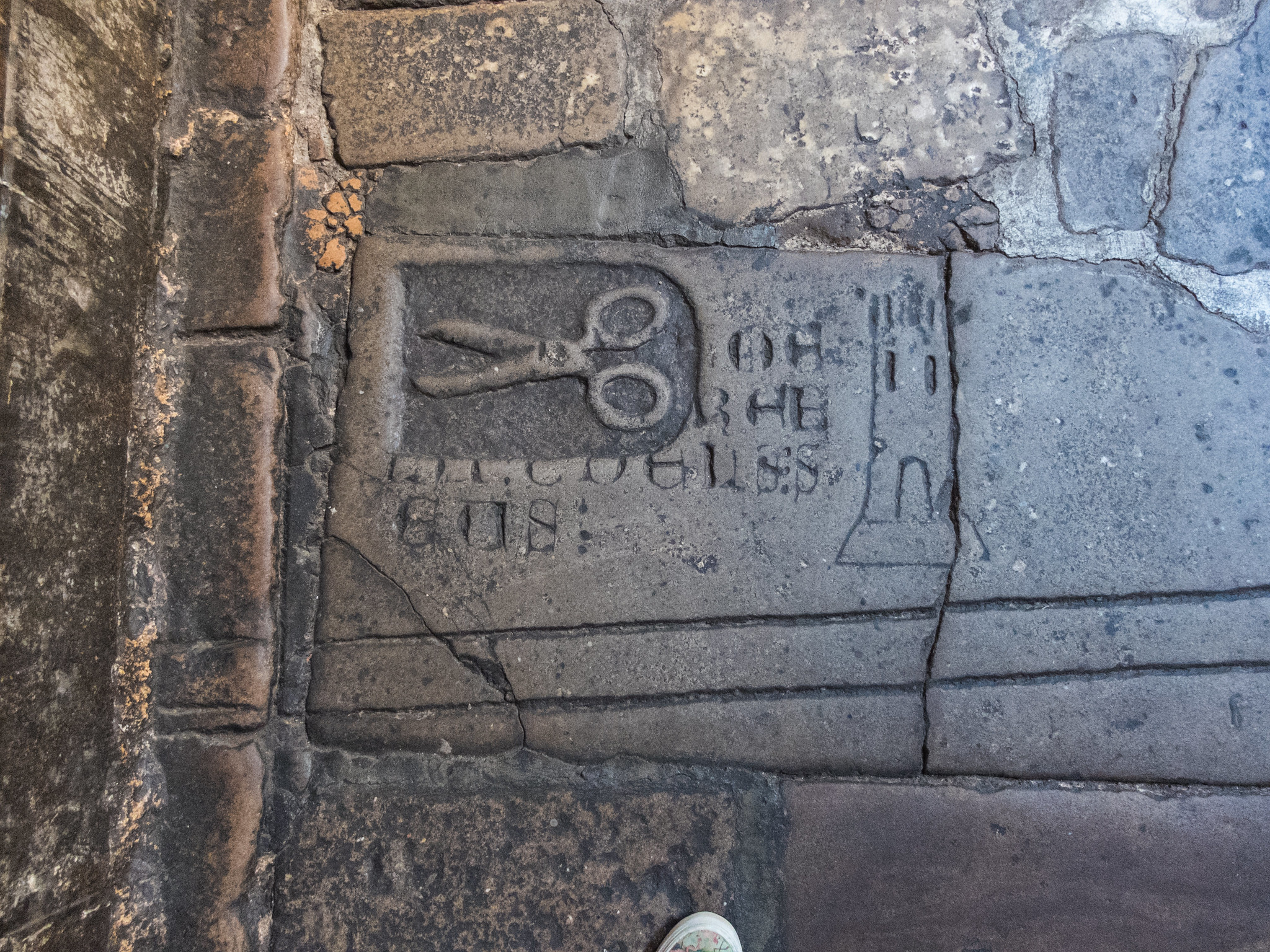
Ou com Balla
In the center of the Cloister is a garden with palm trees, magnolias, an orange tree and a fountain dating from the mid-15th century. The traditional “ou com balla” (the dancing egg) takes place right here each year for the celebration of Corpus Christi. The dancing egg was a trick the church’s acolytes would play where they would empty an egg of its insiders, then fill it with wax and seal the small hole. They could then place the egg atop the fountain’s jet and the egg would start turning without falling, and thus “dances.”

Outside along the walls of the cloister are also several tombs embedded into the walls of the cathedral. These are of important people in the history of Barcelona such as the bronze tomb of Antoni Tallander, the royal jester, as identified by the bels that hang from his belt. There is also the tomb of the Sanllehy family which is marked by the scenes of the burial of Christ.
Geese
In the stone confines of the cloister you might be surprised to find 13 white geese wandering around like they own the place. There are always only 13 geese, one for each of the year’s Saint Eulalia lived. They provide a sunny addition to the otherwise silent cathedral.

Capella de Santa Llúcia
At the Southwest corner of the Closters we find the quiant Romanesque chapel, built in 1257, dedicated to Santa Llúcia. Santa Llúcia is the patron saint of the blind and on December 13th, her saint’s day, you’ll see large numbers of blind people who come to pray at her chapel. Inside the chapel, you can see two ornate sepulchres containing the remains of Bishop Arnau of Gurb (from the 13th century) and Canon Francesc of Santa Coloma (from the 14th century).
This brings us to the end of the tour. Hopefully, you enjoyed exploring it as much as me and learned a little something about Catalan history along the way! Let me know what your favourite part of the Cathedral was or anything else you learned about this amazing place along the way!










2 COMMENTS
blog
5 years agoDoes your website have a contact page? I’m having a tough time locating it but, I’d like to shoot you
an e-mail. I’ve got some ideas for your blog you might be interested
in hearing. Either way, great site and I look forward to seeing it expand over time.
laura.f.whelan
5 years ago AUTHORThanks so much! You can reach me here
https://thecreativeadventurer.com/contact/